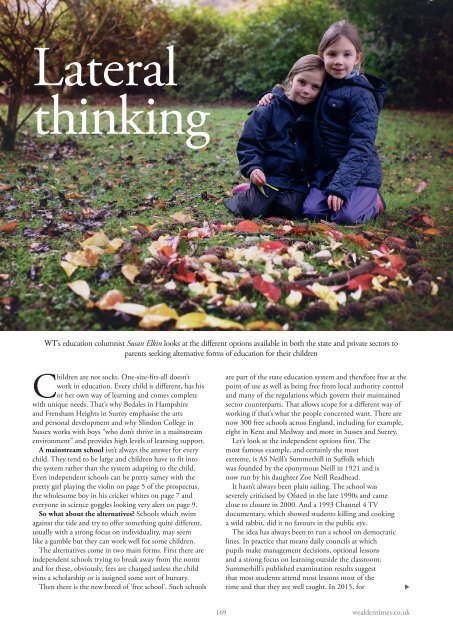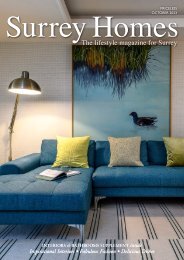Wealden Times | WT176 | October 2016 | Kitchen & Bathroom supplement inside
Wealden Times - The lifestyle magazine for the Weald
Wealden Times - The lifestyle magazine for the Weald
Create successful ePaper yourself
Turn your PDF publications into a flip-book with our unique Google optimized e-Paper software.
Lateral<br />
thinking<br />
WT’s education columnist Susan Elkin looks at the different options available in both the state and private sectors to<br />
parents seeking alternative forms of education for their children<br />
Children are not socks. One-size-fits-all doesn’t<br />
work in education. Every child is different, has his<br />
or her own way of learning and comes complete<br />
with unique needs. That’s why Bedales in Hampshire<br />
and Frensham Heights in Surrey emphasise the arts<br />
and personal development and why Slindon College in<br />
Sussex works with boys “who don’t thrive in a mainstream<br />
environment” and provides high levels of learning support.<br />
A mainstream school isn’t always the answer for every<br />
child. They tend to be large and children have to fit into<br />
the system rather than the system adapting to the child.<br />
Even independent schools can be pretty samey with the<br />
pretty girl playing the violin on page 5 of the prospectus,<br />
the wholesome boy in his cricket whites on page 7 and<br />
everyone in science goggles looking very alert on page 9.<br />
So what about the alternatives? Schools which swim<br />
against the tide and try to offer something quite different,<br />
usually with a strong focus on individuality, may seem<br />
like a gamble but they can work well for some children.<br />
The alternatives come in two main forms. First there are<br />
independent schools trying to break away from the norm<br />
and for these, obviously, fees are charged unless the child<br />
wins a scholarship or is assigned some sort of bursary.<br />
Then there is the new breed of ‘free school’. Such schools<br />
are part of the state education system and therefore free at the<br />
point of use as well as being free from local authority control<br />
and many of the regulations which govern their maintained<br />
sector counterparts. That allows scope for a different way of<br />
working if that’s what the people concerned want. There are<br />
now 300 free schools across England, including for example,<br />
eight in Kent and Medway and more in Sussex and Surrey.<br />
Let’s look at the independent options first. The<br />
most famous example, and certainly the most<br />
extreme, is AS Neill’s Summerhill in Suffolk which<br />
was founded by the eponymous Neill in 1921 and is<br />
now run by his daughter Zoe Neill Readhead.<br />
It hasn’t always been plain sailing. The school was<br />
severely criticised by Ofsted in the late 1990s and came<br />
close to closure in 2000. And a 1993 Channel 4 TV<br />
documentary, which showed students killing and cooking<br />
a wild rabbit, did it no favours in the public eye.<br />
The idea has always been to run a school on democratic<br />
lines. In practice that means daily councils at which<br />
pupils make management decisions, optional lessons<br />
and a strong focus on learning outside the classroom.<br />
Summerhill’s published examination results suggest<br />
that most students attend most lessons most of the<br />
time and that they are well taught. In 2015, for<br />
<br />
169 wealdentimes.co.uk


















